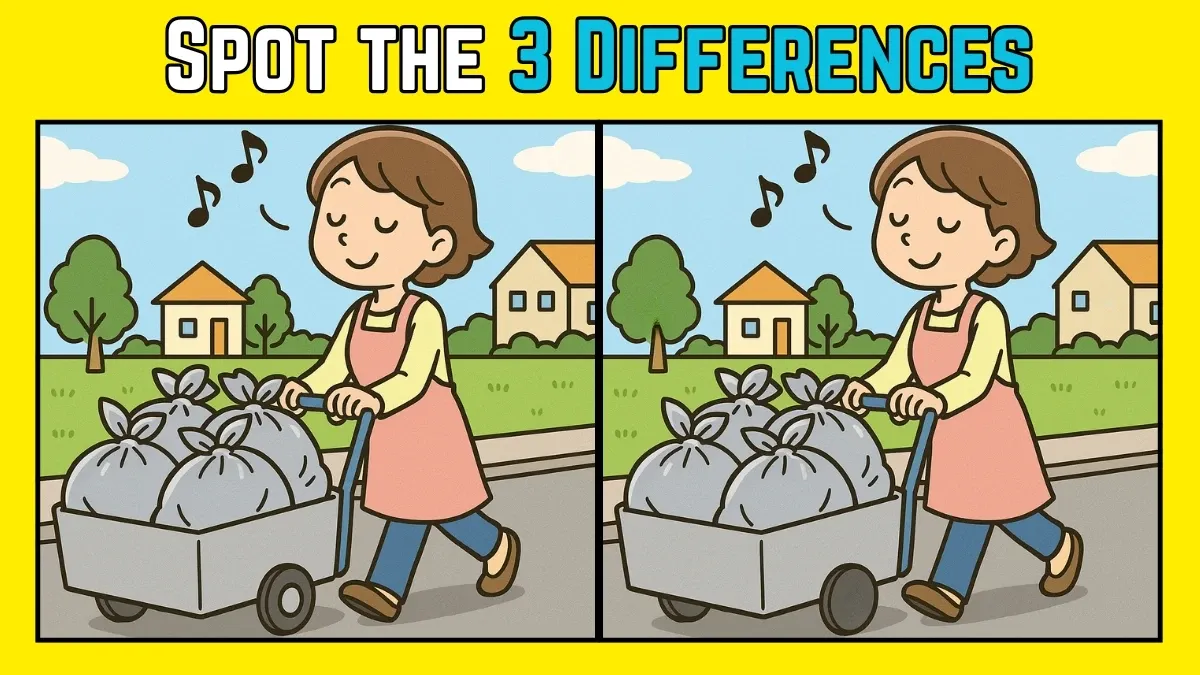In today’s fast-paced world, everyone’s looking for ways to sharpen their mind, improve their focus, and challenge their cognitive abilities. One of the most engaging and entertaining ways to do this is by solving “Spot the Difference” puzzles. These puzzles test not only your visual perception but also your attention to detail and ability to work under time pressure. In this article, we present a thrilling visual puzzle where you have just 8 seconds to spot the three subtle differences in an image of a street vendor scene. Are you ready to give your observation skills a workout?
Why “Spot the Difference” Puzzles Are Great for the Brain
“Spot the Difference” puzzles have been a beloved pastime for decades. But beyond their fun nature, they offer significant cognitive benefits. Engaging in these puzzles requires careful observation, quick thinking, and a high level of focus. They provide a mental workout by challenging you to notice subtle differences in two almost identical images.
Here are a few reasons why these puzzles are so effective for improving cognitive function:
- Improved Visual Perception:
These puzzles help enhance your ability to notice small details that might otherwise go unnoticed. As you compare the two images, your brain learns to distinguish between similar objects, improving your visual perception. - Boosted Memory and Focus:
The challenge of remembering the details of one image while comparing it to the other sharpens your memory. Additionally, the time pressure forces you to concentrate, which helps improve your focus in other tasks. - Enhanced Problem-Solving Skills:
Finding the differences often requires you to think critically and solve visual puzzles. This improves your problem-solving abilities and helps you approach challenges from different angles. - Cognitive Flexibility:
By scanning the images in different ways, you improve cognitive flexibility—the ability to switch between different thought processes. This skill is useful in many aspects of life, especially when you need to adapt quickly to new situations.
The “Street Vendor” Challenge: How to Play
This specific “Spot the Difference” puzzle involves a bustling street vendor scene. At first glance, both images might look nearly identical, but there are three subtle differences hidden within them. Your task is to find all three differences within 8 seconds. It’s a race against time, and only those with sharp observation skills will be able to spot the changes in such a short time.
The beauty of these puzzles lies in their simplicity, but also in their challenge. Often, the differences are tiny—maybe a shift in an object’s position, a missing element, or a slight variation in the scene. These small alterations force you to pay close attention and carefully analyze every detail.
Tips for Spotting the Differences Quickly
Given the short time limit of 8 seconds, the challenge is designed to push your observation skills to the max. Here are some tips that may help you identify the differences in record time:
- Start with the Big Picture:
Scan the image as a whole before diving into specific details. This will help you get a sense of the scene and its overall layout. Once you have an overview, start focusing on smaller details. - Focus on Common Objects:
Look for elements that are present in both images, such as the cart, the tree, and the house in the background. These objects are likely to contain the differences, so focusing on them will make your search more efficient. - Look for Small Changes:
The differences may be subtle, like a missing object or a slight change in positioning. Pay attention to even the smallest details, like the wheel of the cart or the branches of the tree, as these are often the focus of the changes. - Stay Calm and Focused:
With just 8 seconds on the clock, it’s easy to get flustered. However, staying calm and focusing on the task will help you spot the differences faster. Don’t rush—take a deep breath and focus your attention on the image.
Solution: Spot the 3 Differences
Now that you’ve had a chance to scan the image, let’s reveal the three subtle differences in this street vendor scene:
- The Tree’s Branches:
In the first image, the tree in the background on the left side has fewer branches, but in the second image, additional branches appear. This is the first difference and requires a keen eye to spot. - The Window on the House:
In the first image, a window is visible in the house in the background. However, in the second image, the window is completely missing. This slight alteration is often easy to overlook, but it’s key to solving the puzzle. - The Wheel of the Cart:
In the first image, the wheel on the cart is solid, while in the second image, the wheel has spokes. This is the third difference, and it may be a little trickier to notice at first.
The Mental Benefits of “Spot the Difference” Puzzles
Engaging in “Spot the Difference” puzzles not only provides entertainment but also offers various mental benefits. These puzzles stimulate the brain in a way that improves several cognitive functions. Here are a few ways these puzzles help improve your brain:
- Improved Visual Scanning:
By repeatedly looking for differences in images, you develop the ability to scan scenes more efficiently. This skill is valuable in daily life, whether you’re organizing your workspace, reading, or analyzing patterns in data. - Better Attention to Detail:
Spotting subtle differences sharpens your ability to notice small changes. This attention to detail is crucial in various professions and everyday tasks, such as troubleshooting technical issues, making decisions, and observing subtle cues in social interactions. - Increased Mental Agility:
The time pressure in puzzles like this one boosts mental agility. You’re forced to think quickly and make decisions under pressure, which helps improve cognitive flexibility and decision-making speed. - Stress Relief and Relaxation:
While challenging, these puzzles can also be relaxing. Focusing on the puzzle and engaging your brain in a simple yet fun task can reduce stress, providing a healthy mental break from other demanding activities.













